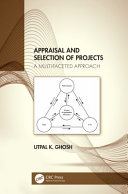Appraisal and Selection of Projects A Multi faceted Approach 1st Edition by Utpal Ghosh ISBN 9781032042282 1032042281
$50.00 Original price was: $50.00.$25.00Current price is: $25.00.
Appraisal and Selection of Projects A Multi faceted Approach 1st Edition by Utpal Ghosh – Ebook PDF Instant Download/Delivery: 9781032042282 ,1032042281
Full download Appraisal and Selection of Projects A Multi faceted Approach 1st Edition after payment

Product details:
ISBN 10: 1032042281
ISBN 13: 9781032042282
Author: Utpal Ghosh
Appraisal and Selection of Projects A Multi faceted Approach 1st Edition Table of contents:
Chapter 1 Characteristics of a Project
1.1 Introduction
1.2 What Is a Project?
1.2.1 Definition
1.2.2 Distinctive Features
1.2.2.1 Change
1.2.2.2 Cost
1.2.2.3 Time
1.2.2.4 Temporary in Nature
1.2.2.5 Uniqueness
1.2.2.6 Resource Dependence
1.2.2.7 Focus on People
1.2.2.8 Uncertainty and Risk
1.2.3 Basic Features
1.3 Project Life Cycle
1.3.1 Idea Stage
1.3.2 Appraisal Stage
1.3.3 Implementation Stage
1.3.4 Benefits Delivery Stage: Realization and Review of the Benefits
Bibliography
Chapter 2 Success and Appraisal of a Project
2.1 Introduction
2.2 Range of Success
2.3 Critical Success Factors
2.3.1 Pre-implementation Stage
2.3.1.1 Definition of the Objective
2.3.1.2 Investigation and Analysis
2.3.1.3 Assessment of Uncertainties and Risks
2.3.1.4 Estimate of Time and Cost
2.3.1.5 Planning
2.3.2 Implementation Stage
2.3.2.1 Financial Support
2.3.2.2 Human Relationship
2.3.2.3 Delegation of Authority
2.3.2.4 Response to Changes in the Plan
2.3.2.5 Contract Terms
2.3.2.6 Communications System
2.3.2.7 Monitoring and Control
2.3.2.8 Safety Aspect
2.3.3 Sponsor
2.3.4 Learning from Experience
2.4 Appraisal
2.4.1 Purposes of Project Appraisal
2.4.2 Appraisal Process
2.4.3 Early Appraisal
2.5 Concluding Remarks
Bibliography
Chapter 3 Market Analysis
3.1 Introduction
3.2 Market Environment
3.2.1 Macro-Environment
3.2.1.1 Political Factors
3.2.1.2 Economic Factors
3.2.1.3 Social Factors
3.2.1.4 Technological Factors
3.2.1.5 Legal Factors
3.2.1.6 Environmental Factors
3.2.2 Micro-Environment
3.2.2.1 Employees
3.2.2.2 Suppliers
3.2.2.3 Local Community
3.2.2.4 Customers
3.2.2.5 Intermediaries
3.2.2.6 Competitors
3.3 Market Analysis Process
3.3.1 Market Survey for Primary Data
3.3.1.1 Census Survey
3.3.1.2 Sample Survey
3.3.2 Existing Reports and Publications (Secondary Data)
3.3.2.1 Market Information
3.3.2.2 Product Features
3.4 Study of Market Characteristics
3.4.1 Market Trend Projection
3.4.2 Market Segmentation
3.4.2.1 Product Specification
3.4.2.2 Geographical Area
3.4.2.3 Consumers
3.4.3 Price Trend
3.4.4 Distribution and Sales Promotion
3.4.5 Consumer Characteristics
3.4.6 Sources of Supply
3.4.7 Government Policy
3.5 Assessment of Future Demand
3.5.1 Qualitative Methods
3.5.1.1 Jury of Executives Opinion Method
3.5.1.2 Delphi Method
3.5.2 Time-Series Projection Methods
3.5.2.1 Trend Projection Method
3.5.2.2 Exponential Smoothing Method
3.5.2.3 Moving Average Method
3.5.3 Causal Methods
3.5.3.1 Chain Ratio Method
3.5.3.2 Consumption-Level Method
3.5.3.3 End-Use Method
3.5.3.4 Econometric Method
3.5.4 Uncertainties in Assessment of Demand
3.6 Market Strategy and Planning
3.6.1 Price Setting
3.6.1.1 Customers
3.6.1.2 Competitors
3.6.1.3 Costs
3.6.1.4 Corporate Objectives
3.6.2 Distribution
3.6.3 Promotional Activities
3.6.4 Customer Service
3.7 Concluding Remarks
Bibliography
Chapter 4 Technical Analysis
4.1 Introduction
4.2 Objectives of the Study
4.3 Material Inputs
4.3.1 Raw Materials
4.3.1.1 Farm Products
4.3.1.2 Mineral Ores
4.3.1.3 Other Products
4.3.2 Processed/Semi-processed Components
4.3.3 Other Supplies
4.4 Technology/Manufacturing Process
4.4.1 Principal Inputs
4.4.2 Product Mix and Quality
4.4.3 Plant Capacity
4.4.4 Scarce Resource
4.4.5 Labor versus Capital Cost
4.4.6 Reliability
4.4.7 Cost of Technology
4.4.8 Absorption of Technology
4.4.9 Environmental Impact
4.4.10 Sustainability under Local Climate Conditions
4.4.11 Services
4.4.12 Local Regulations
4.5 Product Mix
4.6 Plant Capacity
4.6.1 Technological Considerations
4.6.2 Input Constraints
4.6.3 Environmental Considerations
4.6.4 Relationship between Management and Workers
4.6.5 Maintenance
4.6.6 Market Conditions
4.6.7 Resources of the Organization
4.6.8 Government Policy
4.7 Choice of Location
4.7.1 Proximity to Raw Materials
4.7.2 Proximity to Market
4.7.3 Availability of Infrastructural Facilities
4.7.3.1 Transport
4.7.3.2 Power
4.7.3.3 Water
4.7.4 Government Policies
4.7.5 Availability of Supporting Industries
4.7.6 Environmental Pollution
4.7.7 Human Resources
4.7.8 Climate
4.7.9 Living Conditions
4.8 Site Selection
4.8.1 Considerations for Site Selection
4.8.1.1 Size and Shape of the Site
4.8.1.2 Environmental Sensitivity
4.8.1.3 Future Expansion
4.8.1.4 Soil Condition
4.8.1.5 Layout Plan
4.8.2 Estimated Investment Cost
4.8.2.1 Cost of Land
4.8.2.2 Civil Works and Other Expenses
4.9 Selection of Machinery and Equipment
4.9.1 Technology
4.9.2 Plant Type and Capacity
4.9.3 Other Issues
4.10 Construction Activities
Bibliography
Chapter 5 Economic Analysis
5.1 Introduction
5.2 Fundamental Concepts of Economic Analysis
5.2.1 Prologue
5.2.2 Difference between Financial Analysis and Economic Analysis
5.2.3 Study of the Future
5.2.4 Alternative Solutions to be Considered
5.2.5 Quantitative and Qualitative Approaches
5.2.6 Analysis Period
5.2.7 Common Time Datum
5.3 Purposes of Economic Analysis
5.4 Distinctive Features of Economic Strategies for Public Sector and Privately Owned Projects
5.5 Social and Financial Costs and Benefits
5.5.1 Imperfections in Market Prices
5.5.2 Externalities
5.5.3 Taxes and Subsidies
5.5.4 Distribution of Benefits
5.5.5 Concern for Savings
5.5.6 Shadow Pricing
5.5.6.1 Imperfect Pricing Mechanism
5.5.6.2 Variation in Wages Rates
5.5.6.3 Disparity in Interest Rates
5.5.6.4 Disparity in Exchange Rates
5.5.6.5 Inflationary Forces
5.5.6.6 Limitations
5.6 Preparation of Economic Appraisal
5.6.1 Definition of Objective and Scope
5.6.2 Identification of Options
5.6.3 Identification of Quantifiable Monetary Costs and Benefits
5.6.4 Calculation of Quantifiable Net Benefits
5.6.5 Identification of Qualitative Factors and Preparation of Summary of the Results
5.7 Concluding Remarks
Bibliography
Chapter 6 Financial Evaluation
6.1 Introduction
6.2 Yearly Cash Flows
6.3 Time Value of Money (TVM)
6.4 Payback Period
6.4.1 Advantages
6.4.2 Disadvantages
6.5 Return on Investment (ROI)
6.6 Net Present Value (NPV)
6.7 Internal Rate of Return (IRR)
6.8 Comparison between NPV and IRR Methods
6.9 Benefit/Cost Ratio (BCR)
6.10 Drawbacks of BCR
6.11 Concluding Remarks
Bibliography
Chapter 7 Environmental Appraisal
7.1 Introduction
7.2 Project Types
7.3 Meaning and Scope of Environment
7.4 Main Environmental Issues
7.4.1 Population Growth
7.4.2 Global Atmospheric Changes
7.4.3 Pollution
7.4.3.1 Air Pollution
7.4.3.2 Water Pollution
7.4.3.3 Solid and Hazardous Wastes
7.4.3.4 Noise Pollution
7.4.3.5 Other forms of Pollution
7.4.4 Soils and Forests
7.5 Concluding Remarks
Bibliography
Chapter 8 Uncertainty and Risk Analysis
8.1 Introduction
8.2 Uncertainty and Risk
8.3 Benefits of Risk Analysis
8.4 Factors Contributing to Risk
8.4.1 Inaccuracy in the Input Data
8.4.2 Type of the Activity and Future Trend of Economy
8.4.3 Type of Plants and Equipment
8.4.4 Extent of the Estimated Study Period
8.5 Identification of Risks
8.6 Analysis of Risks
8.6.1 Qualitative Risk Analysis
8.6.1.1 Probability and Impact Matrix
8.6.1.2 Brainstorming
8.6.1.3 Delphi Method
8.6.1.4 Lessons Learnt from Previous Projects
8.6.2 Quantitative Risk Analysis: Sensitivity Analysis
8.7 Concluding Remarks
Bibliography
Chapter 9 Life Cycle Costing
9.1 Introduction
9.2 Key Stages of a Project
9.3 Basic Concept of Life Cycle Costing
9.4 Fundamental Issues
9.4.1 Initial Costs
9.4.2 Future Costs
9.4.3 Life of the Structure
9.4.4 Discount Rate and Inflation
9.5 Limitations
9.6 Applications of LCC
9.6.1 Comparing Costs of Alternative Schemes
9.6.2 Choice between Rehabilitation and Replacement
9.6.3 Prioritizing of Resources
9.6.4 Balancing Initial and Future Costs
9.6.5 Improving Productivity in the Workplace
9.7 Stages for LCC Assessment
9.8 Concluding Remarks
Bibliography
Chapter 10 SWOT Analysis
10.1 Introduction
10.2 Team Effort
10.3 Presentation of SWOT Analysis
10.4 Internal Factors: Strengths and Weaknesses
10.5 External Factors: Opportunities and Threats
10.6 SWOT Analysis Process
10.7 Reviewing SWOT Analysis Results
10.8 Advantages of SWOT Analysis
10.9 Limitations of SWOT Analysis
10.10 Applications of SWOT Analysis
10.11 Concluding Remarks
Bibliography
Index
People also search for Appraisal and Selection of Projects A Multi faceted Approach 1st Edition:
2 appraisals
0 appraisal
z-score project management
examples of project selection criteria
what is project appraisal value
Tags: Utpal Ghosh, Appraisal, Selection, Projects, Multi faceted
You may also like…
Earth Sciences
Uncategorized
Computers - Computer Science Computers - Cybernetics
Feature Engineering and Selection: A Practical Approach for Predictive Models 1st Edition Max Kuhn
Medicine - Diseases
Uncategorized
Head and Neck Imaging – A Multi-Disciplinary Team Approach 1st Edition Taranjit Singh Tatla
Computers - Computer Science
Computers - Algorithms and Data Structures
Business & Economics - Real Estate
The Appraisal of Real Estate 15th Edition Appraisal Institute











